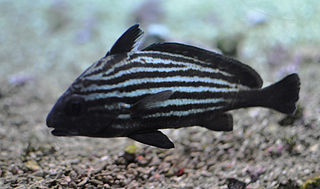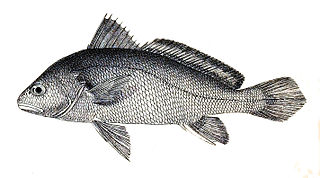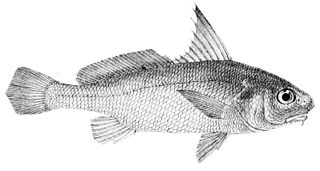
Sciaenidae is a family of ray-finned fishes belonging to the order Acanthuriformes. They are commonly called drums or croakers in reference to the repetitive throbbing or drumming sounds they make. The family consists of about 293 to 298 species in about 66 or 67 genera.

Menticirrhus is a genus of marine ray-finned fish belonging to the family Sciaenidae, the drums or croakers. They are commonly known as kingcroakers or kingfish. These fish are found in the Western Atlantic and Eastern Pacific Oceans.

Micropogonias is a genus of marine ray-finned fishes belonging to the family Sciaenidae, the drums and croakers. These fishes are found in the eastern Pacific and western Atlantic Oceans.

Plagioscion is a genus of freshwater ray-finned fishes belonging to the family Sciaenidae, the drums and croakers. They are found in tropical and subtropical South America where they inhabit fresh and brackish waters. Some species are important food fish and support major fisheries.
The striped croaker, also known as the St Lucian corvina, is a species of marine ray-finned fish belonging to the family Sciaenidae, the drums and croakers. This species is found in the western Atlantic Ocean in the Caribbean Sea and Gulf of Mexico.

Pseudotolithus is a genus of marine ray-finned fish belonging to the family Sciaenidae, the drums or croakers. The species in this genus are found in the Eastern Atlantic Ocean.

Larimichthys is a genus of marine ray-finned fishes belonging to the family Sciaenidae, the drums and croakers. These fishes, commonly known as yellow croakers, are found in the Western Pacific Ocean.

Panna is a genus of marine ray-finned fish belonging to the family Sciaenidae, the drums and croakers. These fishes are found in southern and southeast Asia.

Corvula is a genus of marine ray-finned fishes belonging to the family Sciaenidae, the drums and croakers. These fishes are found in the western Atlantic Ocean and the central eastern Pacific Ocean.

Bairdiella is a genus of marine ray-finned fishes belonging to the family Sciaenidae, the drums and croakers. These fishes are found in the western Atlantic and eastern Pacific Ocean.

Otolithes ruber, commonly known as the tigertooth croaker, silver teraglin, wiretooth, snapper kob, snapper salmon, Yankee whiting or Yankee salmon is a species of marine ray-finned fish belonging to the family Sciaenidae, the drums and croakers. This species is found in the Indo-Pacific region.

Pareques is a genus of marine ray-finned fishes belonging to the family Sciaenidae, the drums and croakers. These fishes are found in the western Atlantic Ocean and eastern Pacific Ocean.

Nibea is a genus of marine ray-finned fishes belonging to the family Sciaenidae, the drums and croakers. The species in this genus are found in the Indo-West Pacific region.

Johnius is a genus of marine ray-finned fishes belonging to the family Sciaenidae, the drums and croakers. They are commonly known as croakers due to their ability to produce purring, croaking and knocking sounds. The sounds are produced mainly at night and are thought to be either involved in defense or for courtship.

The cuja bola is a species of marine ray-finned fish belonging to the family Sciaenidae, the drums and croakers. This fish is found in the northern Indian Ocean in India, Bangladesh, Myanmar and Thailand. It is the only species in the monospecific genus Macrospinosa.

Otolithes is a small genus of marine ray-finned fishes belonging to the family Sciaenidae, the drums and croakers. The three recognised species in the genus are found in the Indo-West Pacific region.

Pachyurus is a genus of freshwater ray-finned fishes belonging to the family Sciaenidae, the drums and croakers. The ten recognised species in the genus are found in South America.

The half-mourning croaker is a species of marine ray-finned fish belonging to the family Sciaenidae, the drums and croakers. It is the only species in the monospecific genus Paranibea. This fish is found in the Indo-Pacific region.

Pennahia is a genus of marine ray-finned fishes belonging to the family Sciaenidae, the drums and croakers. The fishes in this genus are found in the Indo-West Pacific region.

The boe drum is a species of marine ray-finned fish belonging to the family Sciaenidae, the drums and croakers. It is the only species in the monospecific genus Pteroscion. The boe drum is found in the eastern Atlantic Ocean off western coast of Africa.

















